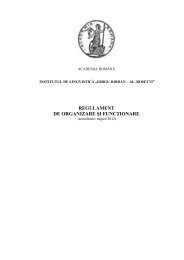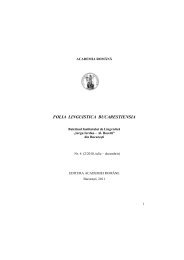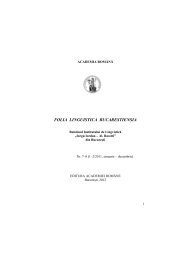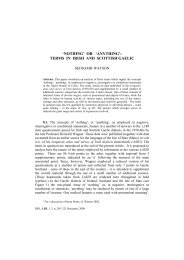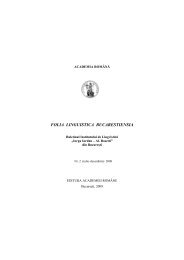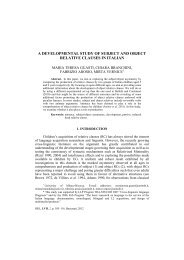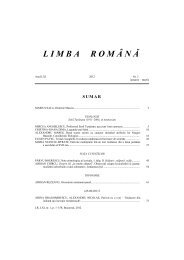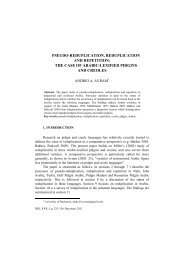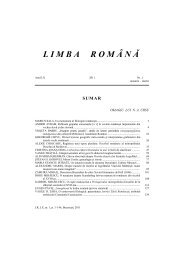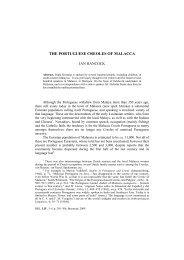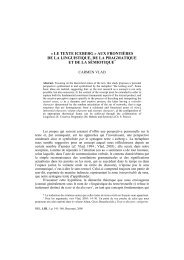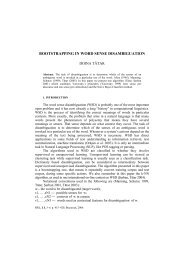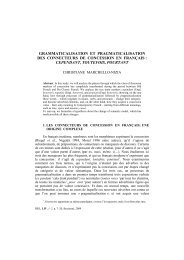GABRIELA PANÄ DINDELEGAN (coord.), Limba românÄ â Aspecte ...
GABRIELA PANÄ DINDELEGAN (coord.), Limba românÄ â Aspecte ...
GABRIELA PANÄ DINDELEGAN (coord.), Limba românÄ â Aspecte ...
- No tags were found...
Create successful ePaper yourself
Turn your PDF publications into a flip-book with our unique Google optimized e-Paper software.
524Comptes rendus 18Being a book especially addressed to students, the information is presented in a gradual way,starting from the primary and most general definitions, theoretical backgrounds and continuing withdetailed data which sustain and demonstrate the basic notions which were first introduced. TheMorphology and psycholinguistics chapter follows this structure and begins with description of themental lexicon concept, using also the parallel with the dictionary. The next stage in describing therelationship between morphology and psycholinguistics is the presentation of the factors involved inthe acquisition of morphology: overgeneralization (which functions both for inflection and wordformation), transparency and simplicity and productivity. The last topic that concerns this chapter isthe models of morphological knowledge (in fact, the main topic of this chapter in our opinion).Without expressing his own opinion on the matter, the author presents the data obtained so far by theresearch: the dual system theory and the single system theories (also called rule-less theories); therule-less theories presented are the connectionist approach (Rumelhart and McClelland, 1986), themost influential one, Bybee’s theory (1988) and the analogy-based model.The last chapter of the book, Morphology and language change is a very sophisticated andrefined lecture of principles that are to be applied in a diachronic study. Bearing in mind theSaussurean paradox (language is simultaneously individual and social in nature), the author partiallyrejects the classical hypothesis of language as a living organism, stating that a language primarilyexists in the minds of its speakers, p. 256. The principles of a diachronic study are presented in thischapter exclusively from the point of view of morphology; a characterisation of the most frequentmorphologic linguistic changes is made (affix telescoping, systematisation, etc.). A part of the chapteris reserved for the description of grammaticalization and of the phenomena related to it: bleaching,degrammaticalization etc.This introduction to linguistic morphology is interesting and useful mainly because of tworeasons: beside chapters like Inflection or Derivation, which can be found in any work dealing withlinguistic morphology, this book contains innovative topics like Interferences and Morphology andMind, i.e. innovative for its status – a textbook. The exposition of the data is clear, with strictdelineations that eliminate the possibility of confusion between the various concepts and ideas.Alexandru NicolaeUniversity of Bucharest – Faculty of LettersIAN ROBERTS, Diachronic Syntax [La syntaxe diachronique], [Oxford,] OxfordUniversity Press, 2007, 528 p.Le dernier livre de Ian Roberts, professeur à l’Université de Cambridge, représente unenouvelle étape de sa réflexion sur la syntaxe comparée et le changement en syntaxe, d’une part, et surle programme minimaliste, d’autre part. S’appuyant en général sur des faits linguistiques en vieilanglais et en ancien français (comme dans Verbs and diachronic syntax [Le verbe et la syntaxediachronique], 1992), ce livre se donne pour fin de présenter certains aspects concernant lechangement en syntaxe. L’auteur veut faire de son livre non un manuel d’analyse syntaxique, mais unguide de recherche historique, et une introduction aux théories linguistiques actuelles. Chaque notionsyntaxique « technique » est présentée dans un petit tableau, et un glossaire en fin d’ouvrage expliqueles concepts avec lesquels il opère.Deux idées de Chomsky gouvernent la présentation des faits de langue : premièrementl’analyse en constituants, les principes combinatoires étant discrets, algorithmiques, récurrents etpurement formels ; secondement, l’idée que les principes fondamentaux de la syntaxe sont universauxet peuvent par conséquent refléter la cognition humaine, donc il peut y avoir une connexion entrechangement linguistique et acquisition de la première langue. L’auteur veut en fait démontrer que lathéorie de Chomsky peut servir non seulement pour la recherche synchronique mais aussi pour l’étudediachronique.



